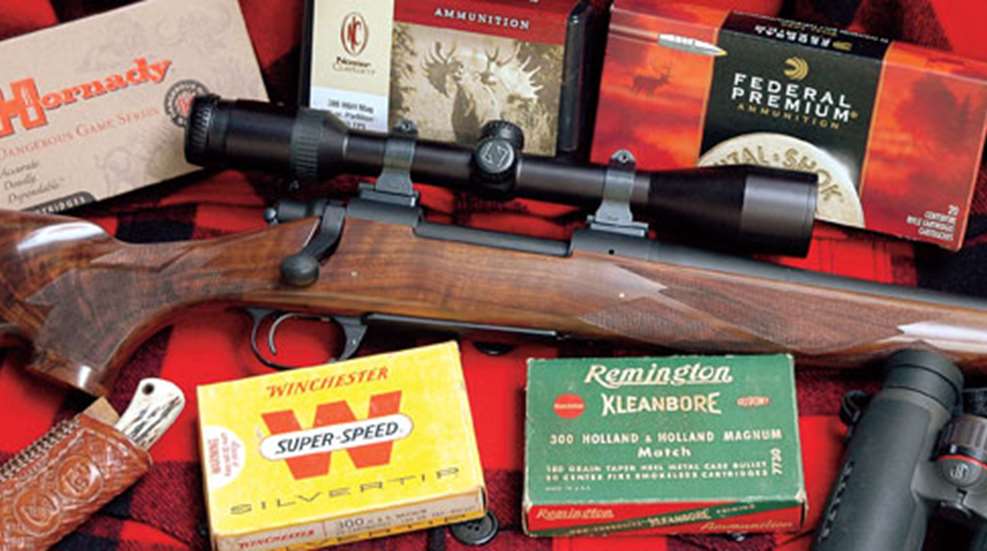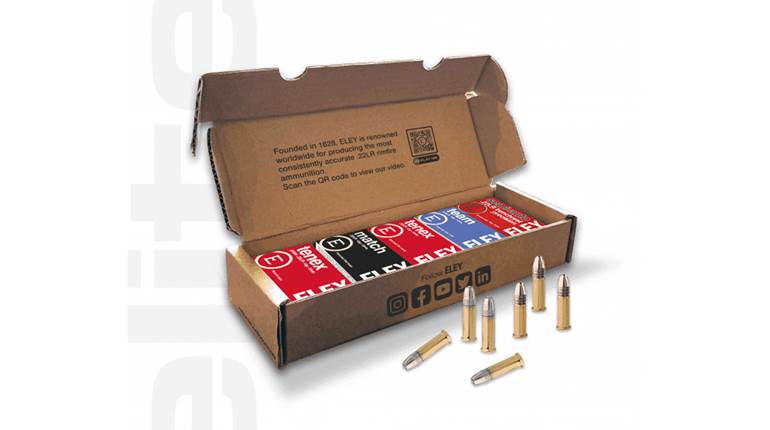
12/27/2012
Most of us who have owned firearms through the years can tell stories about “the ones that got away.” For the most part, gun trades have not caused me a great deal of sadness, but there are a few I should have hung onto. One was a Winchester Model 70 in .300 H&H Mag. purchased soon after I became the proud owner of my first chronograph. The Hodgdon reloading manual I had at the time listed a charge of 75.0 grains of H4831 as maximum with a 180-grain bullet for a velocity of 3,013 fps in a 24-inch barrel. In addition to having a 26-inch barrel, my rifle would take a couple grains more without a whimper, bringing the average muzzle velocity to 3,112 fps with that bullet weight.
According to that same reloading manual, maximum velocities for a 180-grain bullet in the .308 Norma Mag., .300 Win. Mag. .300 Wby. Mag., all in 26-inch barrels, were 3,022, 3,128 and 3,200 fps, respectively. I considered myself in good company with that Model 70 and while it was quite accurate, a previous owner had installed a recoil pad and in so doing shortened its length of pull a bit much for me. So I traded it away.
I had pretty much forgotten about that first rifle in .300 H&H Mag. until 2006 when a friend and I decided to go on a combination hunt in the Yukon for moose, caribou and grizzly. Just for the fun of it, we turned back the calendar several decades by leaving our miracle-fabric clothing and plastic rifle stocks behind; instead, we wore wool and carried pre-’64 Wincheseter Model 70 rifles in .300 H&H Mag. My friend owned both rifles, and the one he used still wore its original Lyman Alaskan 4X scope.
By the time I was on my way home from that hunt I was itching all over for a rifle in .300 H&H Mag. Since the rifle would be built around a classic cartridge, it had to be classical in style and that ruled out a synthetic stock and stainless-steel barreled action in its natural color. But since I planned to really use the rifle, I wanted it to be as resistant as possible to bad weather.
Lex Webernick of Rifles, Inc., kicked off the project by blueprinting a Remington Model 700 action and fitting it with one of Dan Lilja’s match-grade, 26-inch, stainless-steel barrels with three-groove rifling at a twist rate of 1:10 inches. At first glance its Ultra Walnut stock from S&K Industries appears to be nicely figured American walnut and it is, but viewing it from the top reveals two thin layers of carbon fiber sandwiched between two thick layers of walnut. The stock has the warmth and beauty of nicely figured wood and yet, according to the folks at S&K, it is comparable in strength and warp resistance to a multiple-layered, laminated stock and is lighter. We also replaced the factory aluminum trigger guard/floorplate assembly with an all-steel version from Sunny Hill. A test group accompanying the rifle, shot at 100 yards by Webernick, measured a hair under 1/2 inch.
Called the “Super .30” by its developers at Holland & Holland, the .300 H&H Mag. is basically the .375 H&H Mag. case necked down. Introduced in 1925, the new cartridge almost immediately became available to American hunters in imported rifles as well as custom rifles built by Griffin & Howe and others, but it gained very little attention before Ben Comfort used a custom rifle chambered for it to win the 1,000-yard Wimbledon Cup in 1935. His victory got the attention of target shooters, but what really put the cartridge on the map among hunters was its availability in the affordable Winchester Model 70 two years later. Whereas the “Magazine Rifle” described in the Holland & Holland catalog sold for $320 at Abercrombie & Fitch on Madison Avenue, the Model 70 in .300 H&H Mag. was priced at $61.25 in gun shops across America.
Cordite originally loaded in the .300 H&H Mag. was quite sensitive to wide variations in ambient temperature so its developers, who knew the cartridge would be used in tropical climates, reigned it back to mild chamber pressures. Respective velocities for 150-, 180- and 200-grain bullets were 3,000, 2,700 and 2,350 fps. The 180-grain load duplicated the velocity of the .30-’06 Sprg. as it was commercially loaded in the United States in those days. The .300 H&H Mag. received its first boost in performance when the Western Cartridge Co. introduced two loadings, 180 grains at 3,060 fps and 220 grains at 2,730 fps. Winchester and Remington later started loading a 150-grain bullet at 3,090 fps and, while velocities of the 180- and 220-grain bullets were reduced to 2,900 and 2,610 fps, respectively, the .300 H&H Mag. was still faster than the .30-’06 Sprg., which by that time was rated at 2,690 and 2,410 fps with the two heavier bullets.
Despite what benchrest shooters have to say about short and fat being the way to go in cartridges, I find the .300 H&H Mag. quite capable of equaling the accuracy of any other cartridge of its caliber. That first Model 70 in my life many years ago was one of the first big-game rifles I owned that was capable of consistent minute-of-angle accuracy. I eventually got around to shooting three other Model 70s, one of them a target rifle with a 28-inch barrel described by Winchester as the “Bull Gun.” There was also a Remington Model 721 and a 1940s vintage rifle built on the 1917 Enfield action. All except the custom rifle were quite accurate, and even it was accurate enough for shooting game as far away as most hunters attempted in those days.
The barrels of all rifles in .300 H&H Mag. I have handloaded for through the years had a rifling twist rate of 1:10 inches, and they shot accurately with bullets as light as 125 grains and as heavy as the Sierra 220-grain MatchKing. I consider 180 grains to be the optimum weight for all-around use on big game, but bullets on both sides of that can be useful as well. The .300 H&H Mag. is a bit much for lighter game such as pronghorn antelope, but if it were all I had I would load a streamlined bullet weighing 130 to 150 grains for the flattest trajectory possible and then head to sagebrush country. For much larger game capable of striking back—with brown bear in Alaskan alder thickets being a great example—extremely stout bullets of high sectional density such as the 200-grain Swift A-Frame and the Barnes TSX of the same weight, along with the 220-grain Nosler Partition are excellent choices. A friend of mine in Alaska who has used a Remington Model 721 in .300 H&H Mag. to take more moose for the pot than most of us will see in a lifetime, swears by the Sierra 200-grain round-nose handloaded to 2,800 fps.
IMR’s 4350 has long been a popular choice in propellants for this cartridge and for the highest velocities with bullets weighing up to 165 grains, it along with others with similar burn rates such as H4350, RL-19, Big Game and V-N550 continue to be top contenders. They are also excellent choices for accuracy loads with match bullets made by Sierra, Berger and Lapua weighing 165 to 175 grains. Those propellants can be used with heavier bullets but slower burning options, such as RL-22, RL-25, H4831, MagPro and V-N560, often deliver higher velocities at equal levels of accuracy.
Even though Remington and Winchester stopped loading the .300 H&H Mag. some years back, more factory ammunition options are available today than ever before. Federal leads the pack with four 180-grain bullets, Trophy Bonded Tip, Trophy Copper, Barnes TSX and Nosler Partition, all rated at 2,880 fps. Hornady recently added to its Dangerous Game Series the 180-grain InterBond at 2,900 fps, while Nosler offers the AccuBond of the same weight at 2,950 fps in its Trophy Grade line of ammunition. Nosler’s Custom ammunition can be special-ordered with about any bullet offered by that company. And for those who want to turn the clock back to the 1920s, Kynoch ammunition is available with the 180-grain Woodleigh Weldcore at the original velocity of 2,700 fps.
Regardless of whether you go with factory ammunition or load your own, the .300 H&H Mag. has the power and performance for everything from the 1,000-yd. line to moose camp—and quite a few places in between.




































